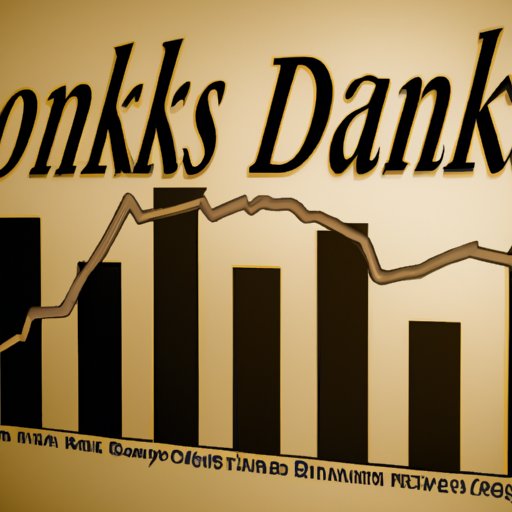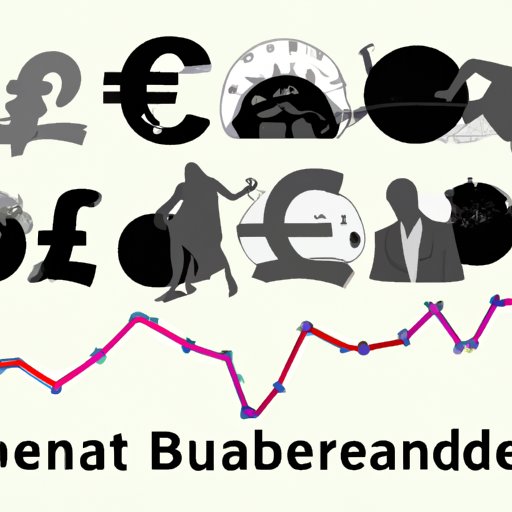Introduction
The Great Depression was a severe economic downturn that began in 1929 and lasted until the late 1930s. During this period, the U.S. economy suffered its worst economic contraction in its history, with unemployment reaching a peak of 25%. While there were many factors that contributed to the severity of the Great Depression, one of the primary causes was the failure of numerous banks throughout the country.
In this article, we will explore how bank failures led to the Great Depression and examine the long-term implications for the U.S. economy.

Analyzing the Causes of Bank Failures During the Great Depression
The Great Depression was triggered by a series of events, including a stock market crash and a banking crisis. The banking crisis was caused by several factors, including over-lending, speculative investments, poor management, and weak regulation.
The Impact of Over-Lending
One of the primary causes of bank failures during the Great Depression was over-lending. Banks had become accustomed to making loans without proper oversight and due diligence, resulting in excessive risk-taking and ultimately leading to a large number of bad loans. This resulted in a large number of defaults and ultimately caused many banks to fail.
Speculative Investments
Another factor contributing to the banking crisis was the practice of banks making speculative investments. Banks had become increasingly involved in the stock market and were investing heavily in risky stocks. When the stock market crashed in 1929, these investments quickly became worthless and many banks were unable to recover from their losses.
Poor Management
In addition to over-lending and speculative investments, poor management was another factor that contributed to the banking crisis. Many banks had inadequate internal controls and did not have sufficient safeguards in place to protect against fraud and other financial mismanagement. This led to a large number of banks becoming insolvent and eventually failing.
Weak Regulation
Finally, weak regulation was another factor that contributed to the banking crisis. Prior to the Great Depression, there was very little oversight of the banking industry and banks were able to operate with virtually no restrictions. This allowed banks to engage in reckless lending practices and ultimately led to a large number of bank failures.

Examining How Bank Failures Impacted the Economy During the Great Depression
The banking crisis of the Great Depression had a devastating impact on the U.S. economy. As banks began to fail, the consequences were far-reaching and long-lasting.
The Collapse of the Stock Market
One of the most immediate effects of the banking crisis was the collapse of the stock market. As the banking system began to implode, investors began to panic and sell off their stocks. This led to a rapid decline in stock prices and ultimately resulted in the Dow Jones Industrial Average dropping by more than 90%.
Decline in Business Activity
As banks began to fail, businesses were unable to access credit and were forced to lay off workers. This led to a sharp decline in business activity and a rapid increase in unemployment. By 1933, industrial production had dropped by more than 50% and unemployment had reached a peak of 25%.
Loss of Consumer Confidence
The banking crisis also led to a loss of consumer confidence. As banks began to fail and people’s savings were lost, consumers stopped spending and began to hoard their money. This led to a further decline in business activity and a deepening of the economic recession.

Understanding the Role of Government Policy in Causing Bank Failures During the Great Depression
In addition to the causes outlined above, government policy also played a role in causing the banking crisis of the Great Depression. Specifically, government policies such as high interest rates and unsound banking practices contributed to the banking crisis.
The Impact of High Interest Rates
During the 1920s, the Federal Reserve had pursued a policy of raising interest rates in order to control inflation. However, this policy had the unintended consequence of making it difficult for banks to borrow money and make loans. This led to a decrease in lending and ultimately contributed to the banking crisis.
Unsound Banking Practices
In addition to high interest rates, government policies also encouraged unsound banking practices. Banks were allowed to hold a large percentage of their assets in risky investments, such as stocks and bonds. This led to a large number of banks becoming insolvent and ultimately failing during the banking crisis.
Investigating the Impact of Bank Failures on the U.S. Economy Following the Great Depression
The banking crisis of the Great Depression had long-lasting effects on the U.S. economy. In the years following the depression, the economy experienced an extended period of stagnation and weak growth.
Economic Downturn
One of the most significant impacts of the banking crisis was an extended period of economic stagnation. As banks failed, businesses were unable to access credit and investment dried up. This led to a prolonged period of weak economic growth and high unemployment.
Increased Unemployment
The banking crisis also led to an increase in unemployment. As businesses were unable to access credit, they were forced to lay off workers. This resulted in an increase in the unemployment rate, which peaked at 25% in 1933.
Decreased Investment
Finally, the banking crisis also led to a decrease in investment. As banks failed, investors became wary of putting their money into the stock market and instead opted to keep their money in cash. This led to a decrease in investment and a further weakening of the economy.
Conclusion
The banking crisis of the Great Depression was one of the primary causes of the economic downturn. Bank failures were caused by a variety of factors, including over-lending, speculative investments, poor management, and weak regulation. These bank failures had a devastating impact on the economy, leading to a collapse of the stock market, a decline in business activity, a loss of consumer confidence, and an extended period of stagnation and weak growth.
The banking crisis of the Great Depression had long-term implications for the U.S. economy. The banking crisis led to an increase in unemployment, a decrease in investment, and an extended period of weak economic growth. It also led to a shift in government policy, with greater emphasis being placed on regulations and oversight of the banking industry.
(Note: Is this article not meeting your expectations? Do you have knowledge or insights to share? Unlock new opportunities and expand your reach by joining our authors team. Click Registration to join us and share your expertise with our readers.)
